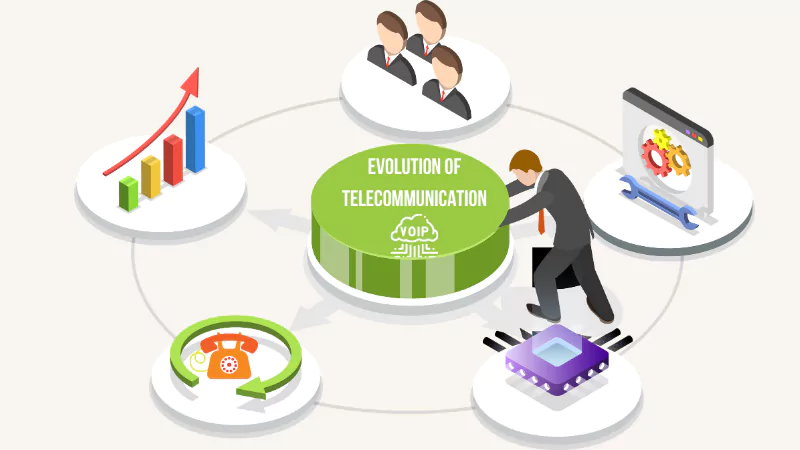Telecommunication technology has come a long way since its inception. From analog telephones to digital VoIP systems, the evolution of telecommunication has drastically transformed the way businesses communicate. One of the latest and most significant advancements in this field is SIP trunking. However, many businesses are still unsure about what it is and what it does. In this blog post, we will delve into the evolution of telecommunication technology and explain the benefits of SIP trunking for businesses, who should adapt and what it needs?
Analog Telephony: The Early Days of Telecommunication
The first telephones were invented in the late 19th century, and the technology was purely analog. Analog phones worked by converting sound waves into electrical signals that were transmitted through copper wires. This technology remained prevalent until the early 2000s, with businesses using PBX (Private Branch Exchange) systems to manage incoming and outgoing calls.
Digital Telephony: The Emergence of VoIP
With the advent of the internet, digital telephony became possible. The first digital telephone systems were introduced in the 1990s, and Voice over Internet Protocol (VoIP) technology emerged as the preferred choice for businesses. VoIP technology converts analog voice signals into digital data packets that are transmitted over the internet. This technology offered significant advantages over analog telephony, including cost savings, flexibility, and scalability.
SIP Trunking: The Latest Evolution in Telecommunication
Session Initiation Protocol (SIP) trunking is the latest advancement in telecommunication technology. SIP trunking is a VoIP service that enables businesses to use the internet to make and receive voice calls. SIP trunking eliminates the need for traditional telephone lines and is a cost-effective solution for businesses that make a large volume of long-distance calls.
SIP trunking works by using a virtual phone line to connect a business’s phone system to the internet. This virtual line replaces traditional telephone lines, and businesses can make and receive calls over the internet. This technology also offers features such as call forwarding, caller ID, and voicemail.
Benefits of SIP Trunking for Businesses
-
- Cost Savings: One of the most significant benefits of SIP trunking is cost savings. Traditional telephone lines can be expensive, particularly for businesses that make a lot of long-distance calls. SIP trunking eliminates the need for traditional telephone lines, resulting in significant cost savings.
- Scalability: SIP trunking is a scalable solution that can easily accommodate business growth. Businesses can add or remove phone lines as needed, and there is no need for additional infrastructure.
- Flexibility: SIP trunking is a flexible solution that can work with any phone system. This technology can integrate with a wide range of PBX systems, including those that are cloud-based.
- Improved Call Quality: SIP trunking offers high-quality voice calls that are clear and reliable. This technology uses advanced voice codecs that optimize call quality and minimize delays and other issues.
- Disaster Recovery: SIP trunking is an ideal solution for disaster recovery. If a business’s phone system goes down, SIP trunking can reroute calls to backup locations or mobile devices, ensuring business continuity.
Is SIP Trunking the Right Choice for You?
Switching from analog to SIP trunking can be a significant decision for businesses. It’s important to consider whether this technology is the right choice for your business needs. Here are some factors to consider:
-
- Business Size: SIP trunking is a cost-effective solution for businesses that make a large volume of long-distance calls. If your business makes a significant number of long-distance calls, SIP trunking can offer significant cost savings.
- Communication Needs: SIP trunking is a flexible solution that can work with any phone system. If your business has a traditional PBX system, SIP trunking can be easily integrated into your existing infrastructure. Additionally, if your business requires advanced communication features such as video conferencing or unified messaging, SIP trunking can offer these capabilities.
- Internet Connection: SIP trunking relies on a stable internet connection to function correctly. If your business has an unreliable internet connection or low bandwidth, SIP trunking may not be the right choice.
What You Need to Switch from Analog to SIP Trunking
To switch from analog to SIP trunking, there are a few things you will need:
-
- Internet Connection: As mentioned earlier, SIP trunking relies on a stable internet connection to function correctly. You will need to ensure that your business has a reliable internet connection with sufficient bandwidth to support your communication needs.
- IP-PBX System: If your business has a traditional PBX system, you will need to upgrade to an IP-PBX system. An IP-PBX system is a phone system that can support SIP trunking.
- SIP Trunking Provider: You will need to choose a SIP trunking provider that can offer the right package for your business needs. It’s essential to choose a reliable provider that can offer quality service and support.
How Long It Takes to Switch from Analog to SIP Trunking
The time it takes to switch from analog to SIP trunking can vary depending on various factors such as the complexity of the existing phone system, the number of phone lines, and the availability of SIP providers. Generally, the process can take anywhere from a few days to several weeks.
Here are the typical steps involved in the switch:
-
- Assessment: The first step is to assess the current phone system and determine the number of phone lines and the types of equipment being used.
- SIP Provider Selection: Once the assessment is complete, businesses can choose a SIP provider that meets their needs in terms of cost, quality, and features.
- SIP Trunking Setup: After selecting a provider, the SIP trunking service must be set up, which involves configuring the system to work with the business’s phone system.
- Testing: Once the system is configured, it’s tested to ensure that calls are being routed correctly and that call quality is satisfactory.
- Cutover: The final step is to cutover to the new SIP trunking service. This involves disconnecting the existing analog lines and connecting the SIP trunking service to the business’s phone system.





